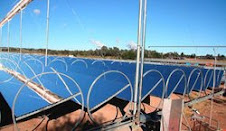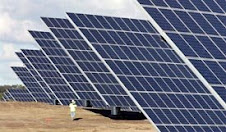FOCUS ON THE ENVIRONMENT
Venturing off the grid; Innovative families save money, gain power with solar, propane, other energy sources
from SFgate.com
Arcata, Humboldt County -- Just past noon on a hazy, raw Sunday a few weeks ago, Linda Parkinson did what few homeowners in this storm-battered region could: She turned on the television.
While most Humboldt County residents were reeling from power outages left by devastating rains, Parkinson had electricity to spare. She cooked a feast for a dozen people, took hot showers and threw video-game parties for her 15-year-old son's classmates.
For 24 years, Parkinson, 49, has lived completely off the electric grid, drawing energy exclusively from solar, propane and other renewable on-site power sources.
She isn't alone. Some 180,000 American homeowners live off-grid, according to Richard Perez, publisher of Home Power magazine. Approximately a quarter live in California, and each year the national number grows 33 percent, according to the publisher's database of known off-gridders and estimates of those unreported.
"California is the hotbed of off-grid systems," he said.
Parkinson maintains that the movement is no longer a hippie fad; it's increasingly mainstream and propelled by Americans' desire to eliminate electric bills, keep homes juiced during blackouts, minimize U.S. dependence on fossil fuel and, for activists, send a gesture of defiance to the power companies.
"It's about self-sufficiency," she said, relaxing on the couch in her secluded home. "Living off the grid doesn't mean being disconnected. If anything, I've had an advantage. The power goes out a lot around here," and she still manages to crank household appliances.
In the wireless era, Parkinson said, technology both frees us up and plugs us in, and the off-grid choice is not a retreat from technology but an application of it.
Over the past few months, the off-grid movement has burst into pop-culture awareness: Several online groups have formed with tips on refrigeration, lighting and rainwater distillation; there's a series of new off-grid design books; and the U.S. Department of Energy hosted in October its second design competition for off-grid architects.
The strongest sign yet of the movement's liftoff is a reality-TV series, due out this fall on the Discovery Channel. Production for "Off the Grid" -- its tentative name -- is to start in May.
"We'd rather call it an 'informational documentary' than a reality-TV series," insisted producer Katie Sole, who is preparing to recruit American families. "These families are city dwellers who've always had dreams of escaping the rat race."
Participants will build log cabins, hunt, fish and grow crops. While the movement's impact is crystallizing for cultural consumption, its lobbying powers in government are just forming.
A recent study by the U.S. Public Interest Research Group, a lobbying organization based in Washington, D.C., found that an increase in America's alternative-energy investment, after 15 years, would create almost 150,000 jobs, increase wages nearly $7 billion, reduce carbon-dioxide emissions roughly 30 percent and save close to $30 billion in electric and gas bills.
The technology that frees a homeowner from PG&E bills includes rooftop panels that absorb sunlight and convert it to electricity, which is then stored in batteries; spinning wind turbines that generate electricity; and gravity-based plumbing that sends creek water and rainwater through pipes funneled into an irrigation pond.
A typical off-grid setup, with solar and wind systems, costs thousands of dollars. An upscale system in a house of 2,000 square feet, for instance, costs more than $23,000 to purchase and install.
That's how much Lauris Phillips, 48, and Jay Peltz, 46, paid to power their house in Redway, just outside Garberville.
"It can be expensive, but the equipment pays for itself after several years," said Peltz, standing under a canopy of solar panels in a patch of sunlight. Peltz is an acclaimed solar-panel consultant who recently set up a biological-research center in Ecuador.
Technology aside, Peltz said, the movement owes itself, in part, to texts like Henry David Thoreau's "Walden," the classic 1854 study of self-sufficient living. "I went to the woods because I wished to live deliberately," Thoreau wrote. The same is true of many off-gridders, but while self-reliance is its own reward, Peltz emphasized, the biggest appeal is cost: After several years, you save more than you've spent.
"I've saved $200 a month for the last 20 years," Parkinson said. "That's my kids' education right there that I would have given to PG&E."
Passive solar buildings have been in use since the 1940s, when World War II quickened an energy crunch that led Americans to seek out alternative power sources. In 1954, Bell Laboratories invented solar panels to strengthen phone signals, but the technology didn't reach homes until the '70s.
Although the United States is the birthplace of the off-grid movement, Japan is the top producer of solar technology, and Germany also invests more heavily, which Peltz believes will reduce those countries' trade deficits, produce jobs and lessen their reliance on oil imports.
Lobbying from solar advocates will help the United States retake the lead, Peltz said. Such lobbying intensified in 1980 with the first off-grid house on a college campus, constructed at Humboldt State University when students formed the Campus Center for Appropriate Technology. Today CCAT -- the campus' largest organization -- is renowned for its quirky alternative-energy projects, such as pedal-powered exercise-bike laptops, blenders and VCRs.
The center, which has an annual budget of $34,000 that doubles every five years, installed solar panels in 1984. Controversy struck in 2000 when the students chose to plug back into the grid to earn rebates from PG&E, contribute energy to the power company and ease the grid's overall load.
"It makes the whole thing cheaper," said Richard Engle, a Humboldt State research engineer. "CCAT could stubbornly stay off the grid and tout renewable energy as 'sticking it to the man,' but we -- those supporting the move -- felt it sent a more powerful message" to supply additional energy to the grid.
With the recent passage of a campuswide initiative, students now pay $10 per semester to get the entire college off the grid by 2043.
A major reason for the off-grid trend's growth in Humboldt is real estate. Acres of scenic land are beyond the grid's reach, and off-grid technology allows for settling just about anywhere.
There's also the crop industry. "Honestly, the marijuana industry is a big factor," said Jim Zoellick, another Humboldt State engineer. "Back in the '80s, there were people living in the hills growing pot, and they didn't want the grid coming out because they didn't want PG&E running their meters. The marijuana industry was a tremendous market."
Still another reason is fear.
After the paralyzing blackouts that struck California in 1996 and 2001 and the Y2K hysteria about technological collapse come midnight 1999, more urbanites moved off the grid.
Another oft-cited factor is the attacks of Sept. 11, 2001, the fallout from which has inspired people to rethink the invincibility of cities.
Now, members of a Yahoo chat-group called Off-Grid Living and Homesteading trade dozens of e-mails daily. One post last month, by newcomer Willow Polson, said she is "seriously looking at getting our 20-acre homestead off the grid" and becoming "as self-sufficient as possible. (We believe strongly that because of peak oil and other factors, a depression is coming very soon.)"
Polson, 39, grew up in San Francisco and lives near Yosemite with two sheep, three chickens, four cats and two dogs.
Speaking with The Chronicle shortly after her initial post, she added, "I don't want to sound like some survivalist nut-cake, but moving out here, in the middle of nowhere, we have to be ready for whatever can happen."
"It's still so new," said Lori Ryker, author of the new design book "Off the Grid." "The movement didn't take off as well in the '70s. That's because it takes a while for a paradigm shift to occur in the way people think."
OMNI IRAN ANTHOLOGY #34 January 17, 2026
27 minutes ago






No comments:
Post a Comment